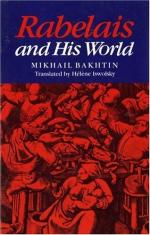
|
| Name: _________________________ | Period: ___________________ |
This quiz consists of 5 multiple choice and 5 short answer questions through Chapter 16, Chapter 7 - Rabelais' Images & His Time.
Multiple Choice Questions
1. Why, according to Bakhtin, does Rabelais treat excrement ambivalently?
(a) Because it is evidence of humankind's presence on the earth.
(b) Because it exclusively connotes badness or evil.
(c) Because it is intermediate between earth and body.
(d) Because its purpose was a mystery in the Renaissance.
2. To what does Bakhtin compare the various cries of Paris?
(a) A sobbing child.
(b) A crowded kitchen.
(c) A howling wolf.
(d) A roaring storm.
3. In Rabelais' time, the word "drum" and the act of drumming connoted:
(a) Spiritual awakening.
(b) Death.
(c) Sexuality.
(d) Nature.
4. How are abusive and praiseful words reflective of grotesque realism?
(a) The words are spoken in a language the listener cannot understand, so they sound like gibberish.
(b) The words reflect incompatible sides of certain social classes of people.
(c) The words combine two sides of the same form or feeling into an ambivalent but cohesive social structure.
(d) The words are carefully chosen by the speaker to disgust the listener.
5. What does Rabelais parody in his response to the episode of Gargantua's birth?
(a) The Classical philosophy of stoicism.
(b) The Renaissance philosophy of humanism.
(c) The Medieval doctrine of faith.
(d) The Christian doctrine of submission.
Short Answer Questions
1. According to Bakhtin, what is the function of art?
2. What was the reception of Rabelais' work in the eighteenth century?
3. What do Rabelais' various works indicate about the popular notion of urination?
4. Bakhtin finds that ___________ are especially closely interwoven with the grotesque body.
5. How does Bakhtin interpret Rabelais' work as a response to the hardships of France in 1532?
|
This section contains 377 words (approx. 2 pages at 300 words per page) |

|




